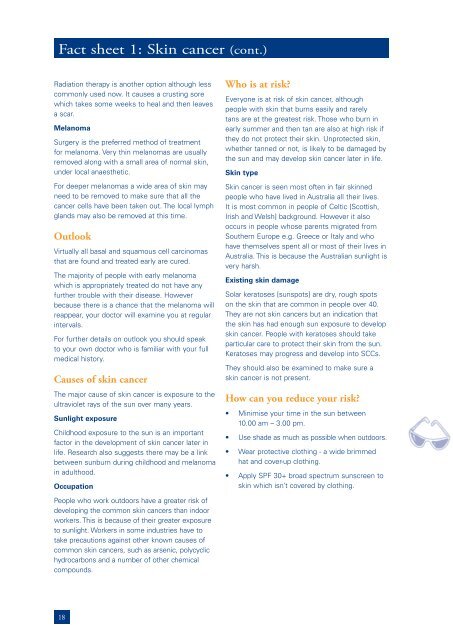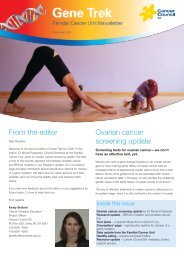Be SunSmart final print file.indd - Cancer Council SA
Be SunSmart final print file.indd - Cancer Council SA
Be SunSmart final print file.indd - Cancer Council SA
Create successful ePaper yourself
Turn your PDF publications into a flip-book with our unique Google optimized e-Paper software.
Fact sheet 1: Skin cancer (cont.)<br />
Radiation therapy is another option although less<br />
commonly used now. It causes a crusting sore<br />
which takes some weeks to heal and then leaves<br />
a scar.<br />
Melanoma<br />
Surgery is the preferred method of treatment<br />
for melanoma. Very thin melanomas are usually<br />
removed along with a small area of normal skin,<br />
under local anaesthetic.<br />
For deeper melanomas a wide area of skin may<br />
need to be removed to make sure that all the<br />
cancer cells have been taken out. The local lymph<br />
glands may also be removed at this time.<br />
Outlook<br />
Virtually all basal and squamous cell carcinomas<br />
that are found and treated early are cured.<br />
The majority of people with early melanoma<br />
which is appropriately treated do not have any<br />
further trouble with their disease. However<br />
because there is a chance that the melanoma will<br />
reappear, your doctor will examine you at regular<br />
intervals.<br />
For further details on outlook you should speak<br />
to your own doctor who is familiar with your full<br />
medical history.<br />
Causes of skin cancer<br />
The major cause of skin cancer is exposure to the<br />
ultraviolet rays of the sun over many years.<br />
Sunlight exposure<br />
Childhood exposure to the sun is an important<br />
factor in the development of skin cancer later in<br />
life. Research also suggests there may be a link<br />
between sunburn during childhood and melanoma<br />
in adulthood.<br />
Occupation<br />
People who work outdoors have a greater risk of<br />
developing the common skin cancers than indoor<br />
workers. This is because of their greater exposure<br />
to sunlight. Workers in some industries have to<br />
take precautions against other known causes of<br />
common skin cancers, such as arsenic, polycyclic<br />
hydrocarbons and a number of other chemical<br />
compounds.<br />
18<br />
Who is at risk?<br />
Everyone is at risk of skin cancer, although<br />
people with skin that burns easily and rarely<br />
tans are at the greatest risk. Those who burn in<br />
early summer and then tan are also at high risk if<br />
they do not protect their skin. Unprotected skin,<br />
whether tanned or not, is likely to be damaged by<br />
the sun and may develop skin cancer later in life.<br />
Skin type<br />
Skin cancer is seen most often in fair skinned<br />
people who have lived in Australia all their lives.<br />
It is most common in people of Celtic [Scottish,<br />
Irish and Welsh] background. However it also<br />
occurs in people whose parents migrated from<br />
Southern Europe e.g. Greece or Italy and who<br />
have themselves spent all or most of their lives in<br />
Australia. This is because the Australian sunlight is<br />
very harsh.<br />
Existing skin damage<br />
Solar keratoses [sunspots] are dry, rough spots<br />
on the skin that are common in people over 40.<br />
They are not skin cancers but an indication that<br />
the skin has had enough sun exposure to develop<br />
skin cancer. People with keratoses should take<br />
particular care to protect their skin from the sun.<br />
Keratoses may progress and develop into SCCs.<br />
They should also be examined to make sure a<br />
skin cancer is not present.<br />
How can you reduce your risk?<br />
•<br />
•<br />
•<br />
•<br />
Minimise your time in the sun between<br />
10.00 am – 3.00 pm.<br />
Use shade as much as possible when outdoors.<br />
Wear protective clothing - a wide brimmed<br />
hat and cover-up clothing.<br />
Apply SPF 30+ broad spectrum sunscreen to<br />
skin which isn’t covered by clothing.



